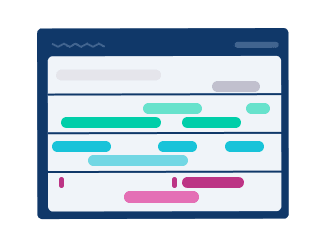Updated: April 25, 2024- 10 min read
This month we’re talking about all things products for Product Managers. And you’ve just landed on your one-stop shop for designing your product technology stack!

Choosing a product stack that works for your teams better enables them to glide through the development process with no roadblocks or bottlenecks. OK it can’t do that, but it can make it easier!
Here we’ll go through the building blocks of a great product stack, give you our advice on how to choose and adopt tools, and our recommendations for the best digital products.
Rather than the big stuff (programming languages, servers, etc) we’re going to help you with the day to day product stack that you use to run meetings, collaborate, and communicate.
What Is a Product/Tech Stack?
A Product Stack and a Tech Stack are two names for the same thing: the collection of tools, products, platforms, and suites that teams use to build digital products or to run a digital business. But a product stack is so much more than just the tools you use, it’s how they create your tech ecosystem and form the machine that keeps your business going.
You might also have your own personal product stack that helps you to get through your workload.
Even if you’re a two-person team building a startup, and all you have is the free version of Slack and Google Docs…congratulations, that’s your product stack!
It’s important to get your product stack right, because getting it wrong causes friction and bottlenecks and generally makes life for everyone involved in product development a bit rough. Empowering your teams with the right tools to get the job done will help them to build the right product, as it involves everything from how they talk to each other and plan projects, to how they write code and launch features.
You might also be interested in: What Is Product Ops?
Components of a product stack
This is by no means an exhaustive list of what can go into a product stack. It entirely depends on what kind of products you’re building. But in general the areas to consider are…

Communication:
This is a major, multi-faceted consideration in your product stack. Your first, and most basic decision to make is how internal communication will go. Most of the tech industry runs on Slack, or Microsoft teams, as email has been relegated to third-party communications. You need to figure out what will work best for your teams and your organization.
Data management:
You need to decide the best way to collect, store, analyze, and present your data. The one thing you don’t want to do is neglect your product analytics and think to yourself, ‘we’ll invest in X expensive data suite when we have the cash, and we won’t worry about it until then.’ A cheap data solution is better than no data solution! So even if all you have access to to start with is Google Analytics, that’s better than letting your valuable data slip through your fingers.
As you scale, you’ll need a solution that gets more sophisticated with time. As you iterate on your product, you’ll need a deeper understanding of your customers and how they use your product. You’ll also need to get more people involved in your data, and to make it accessible to cross-functional teams. So choosing a suite that is as user-friendly as it is powerful may be key.
HR/people management:
Yes, this is an important consideration in your product stack. The easier your HR/admin processes are, the less brain power they’ll take from team leaders. It should feel effortless to schedule a 1-1 performance review, create a job posting for a new position, and book PTO.
It’s easy to forget to make this a priority when considering your product stack, but making it easier to be an employee at your company makes it easier to build products at your company. Providing a great experience for team members will also increase your employee retention, which both saves money and reduces disruption.
Roadmapping:
Every product person’s favorite and most beloved document…the roadmap! Digital roadmapping products have come a long way in recent years, and it’s easier than ever to create, manage, and (most importantly) communicate a product roadmap.
When choosing your roadmap platform, think about all the teams that need to use it, because it’s never just the engineering teams or just the leadership teams. Marketing, design, sales, enterprise…basically anyone in your org can benefit from having access to the roadmap. In certain scenarios, it’s even valuable to have a version of your roadmap that you can communicate with your customers.
You might also be interested in: Product Roadmap Template

Project planning:
Project planning is another important aspect of product development. It may be possible to repurpose your roadmapping tool to use for project planning. But if you’re working at scale with large teams, it may be wiser to invest in a made-for-purpose project planning tool. Picking one great tool that all teams can use will keep everyone using the same platform. You don’t want them to go rogue and have each team using something different, as that’ll make cross-functional collaboration more difficult.
Having one platform for all teams to use helps to facilitate understanding of each other’s capacity, as it helps teams to speak each other’s language. Marketing will easily be able to see how much help they can expect from Engineering. Sales will be able to see what launches Marketing has coming up etc.
Online collaboration:
Online collaboration products have become a category all of their own, whether they be online whiteboards like MURAL or design tools like Figma. (If you’re keen to explore these types of tools, we’ve created some free templates to get you started!)
The coolest thing about these products, and what makes them a worthwhile investment, is that they don’t just fill the need created by remote working. They’ve actually made product team’s lives easier even when they go back to the office.
Design:
When choosing your design products, it’s key to think about all the different reasons for having one in the first place. Your product teams and designers will want to be able to build prototypes, and your marketers will want to make blog graphics and social media posts. Before choosing a design tool, make a list of your design needs and try to find one that ticks all the boxes, or at least as many as possible.
Certain teams will need a more sophisticated design product, and others will require something user-friendly, so it’s likely that you’ll need to provide teams with a couple of options.
User experience/research:
Users are the lifeblood of your product, so it’s worth investing in platforms and processes to help you understand them better. You need to know who they are, what they like, what problems they have, and countless other things about them.
Once you’ve launched your product you also need tools (like heatmaps for example) that can tell you how they behave within your product. They may be using your product in a way that you didn’t expect.
User research tools can answer a lot of questions about your product and your customers.
You might also be interested in: Product Management Skills: User Research
Understanding Your Tech Needs (And Budget!)
The biggest mistake you can make when building a new product stack is to assume that a. you already know what tech solutions you need and b. which products provide those solutions.
Instead of saying to yourself, “we need a new prototyping product, I hear Figma is popular”, break down what your actual needs are. It’s the same thing you do for your customers, when you think about the problem before providing solutions.
Instead of thinking “All companies use Salesforce right? That means we need Salesforce right now.” Salesforce is certainly a mainstay of the tech industry’s stack favorites. But it also comes with a price tag, and it may be out of your budget if you’re in the early stages of building something.
Stop thinking about what you think you should have, and think about what you need. Whether you’re basically starting from scratch, or going through growing pains and in search of the right solutions to fix it, here’s what you need to be thinking about:
What products do my teams tell me they need? Great Product leaders listen instead of preach. Listen to the problems that your teams have and find the products that can solve them.
What limitations does our current stack have? Is there something your current data tracking software lacks? Or are your roadmaps a little lackluster? Take a look at what you already have and try to find solutions that fill the gaps.
What needs do we have that can be filled by software? If you’re not tracking and managing your product data, you clearly need a data analytics platform. If your designers are limited by the functionality of their current design suite, it’s time to look into design tools, etc. Focus on the need and not the product you think you need.
Another important consideration, beyond need and budget, is the knowledge level of your teammates. There’s no point in giving your teams the world’s most powerful data suite if most of them can’t write a single line of SQL. It’s equally redundant to choose a beginner-friendly data platform that only your Data Scientists are going to touch. Your stack needs to fit the hands that are going to be using it, so think carefully about how easy a piece of software is to adopt before you select it for your teams.
Asking for more budget

Product Managers are rarely in charge of dictating the budget their team has for tools and software.
In general, it’s always good to overestimate how much you’ll need rather than underestimate. If you overestimate, you get to turn around and say, ‘Hey, we achieved our goals and we even managed to do it under budget. Isn’t that great?’ And that’s going to be much more positively received than ‘Actually…we need more cash.’
It’s a meeting that’s typically better done face to face, rather than via email. So set up a Zoom call or an in-person meeting with the decision maker, with the express purpose of going over the budget. Being upfront and transparent about what you need right from the start is the best way to go.
Have a new budget prepared, with a breakdown of the new costs, why these costs are justified, and back yourself up with as much data as possible.
You only get one shot at asking for more budget, so make sure you have the answer to every question the decision maker is likely to have. But make sure you don’t walk into the room (Zoom or otherwise) and flood them with all the information you have. Make your case clearly and succinctly, and keep the rest of the information you have in your back pocket until you’re asked for it. It’ll help you to keep the conversation focused, while being prepared to make a great case.
Coming Up in Part 2
Now that you understand your needs, and you have your budget all ready, it’s time to choose your products, and implement them into your stack. But there’s still a lot to consider. Which products are the right ones for your team? Should you build vs buy? What about stack vs suite?
Updated: April 25, 2024





